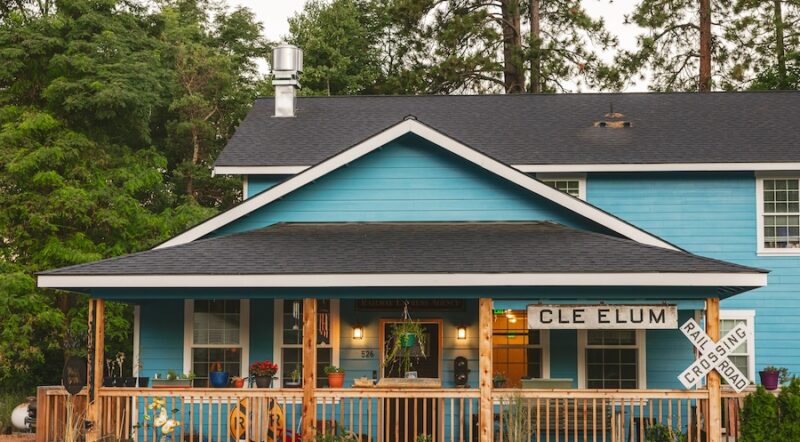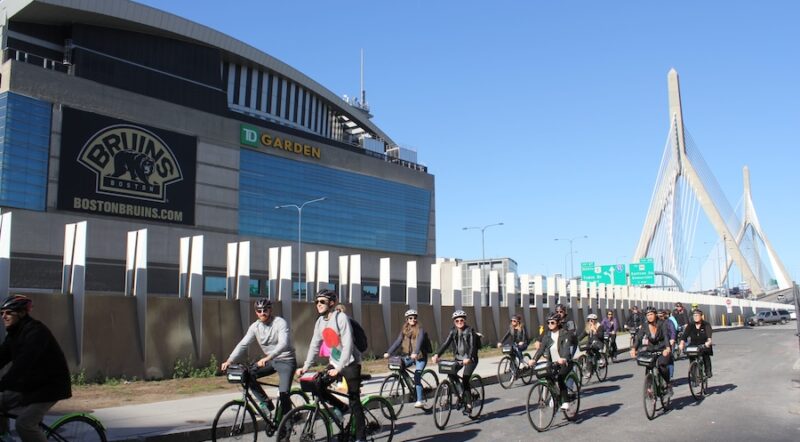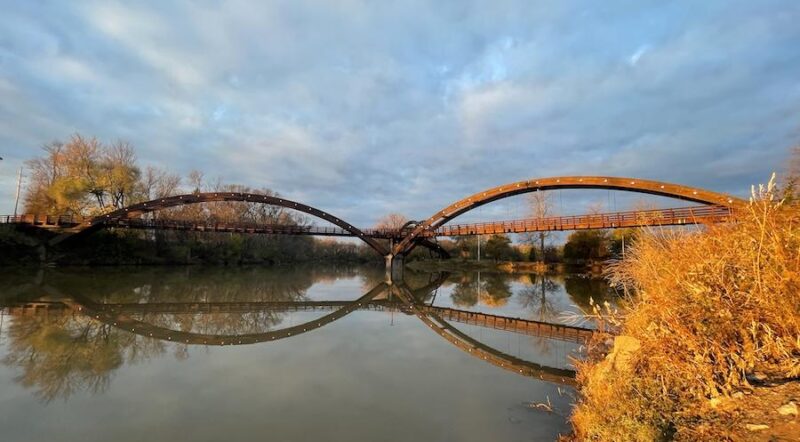Iowa’s Cedar Valley Nature Trail

Trail of the Month: May 2019
“Just in that original 52-mile stretch, you can see every ecosystem that Iowa has to offer.”
—Cherrie Northrup, planning administrator for Black Hawk County Conservation
When you visit the website that lists the dozens of parks, trails and wildlife areas managed by Black Hawk County Conservation, you will find a link to a drone video that showcases eastern Iowa from above. As the camera pans above one of the highlighted areas, the Cedar Valley Nature Trail, it reveals one shot after another of riverway, cottonwoods, elms and wildflowers—a wild and beautiful natural landscape.
“You wouldn’t dream that’s in Iowa,” said Cherrie Northrup, the county’s planning administrator. “Just in that original 52-mile stretch, you can see every ecosystem that Iowa has to offer.”
Managed by Black Hawk and Linn counties, the Cedar Valley Nature Trail (CVNT) is so often referred to as the backbone of the expansive trail system that has developed around it that Northrup said there have been conversations about branding it that way.
For now, the trail’s users and caretakers are embracing that the CVNT is a gateway trail along the recently announced Great American Rail-Trail. “I’m very excited that we are on the route and right in the middle of the country,” said Kim Manning, manager of the Cedar Falls Tourism and Visitors Bureau. “I’m not terribly surprised, because the Cedar Valley Nature Trail is one of the oldest rail-trails in the country.”
DON’T MISS: From Dream to National Treasure: The Great American Rail-Trail
Indeed, the trail, which debuted in 1984, has quite the history, one which prominently features perseverance. Built upon a 1910s rail line, the trail’s aging bridges are routinely inspected to assess their structural integrity. The need to do so was underscored by the Cedar River flood of 2008, a $6 billion disaster which Northrup said caused $6 million worth of damage to the trail alone. The flood wiped out large swaths of the CVNT and destroyed two historical bridges that connected it. It took years, but both have been replaced, and the funding is in place to rebuild a key connecting bridge that’s currently unfit to pass.
A Trail Grows in Iowa
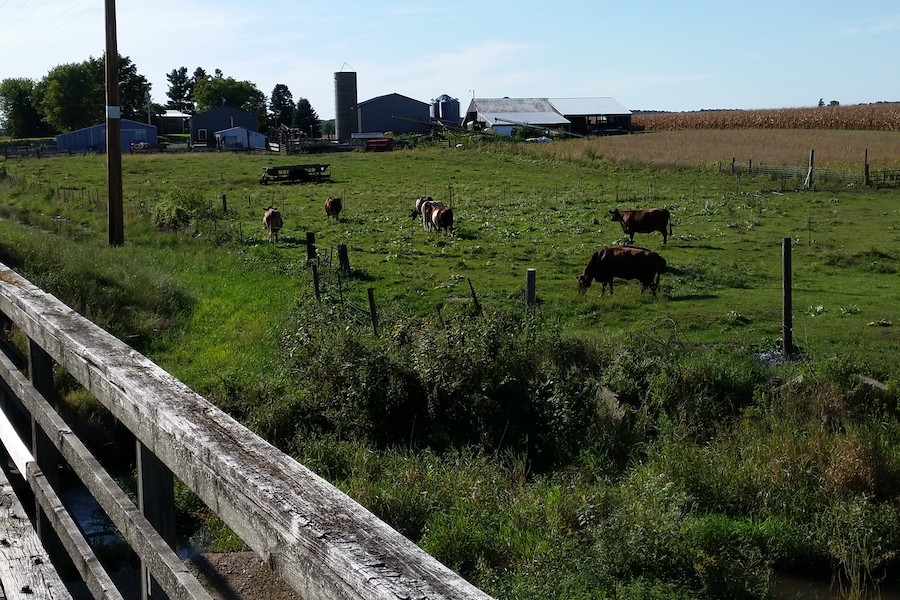
Depending on who you ask, the Cedar Valley Nature Trail is either 52 miles long (the original length) or about 67 miles thanks to extension projects in Linn County. The trail’s website includes maps for both iterations. Both versions begin in Evansdale to the north and run south through a collection of small towns (Gilbertville, La Porte City, Brandon, Urbana, Center Point, Robins and Hiawatha) before reaching Cedar Rapids and, as the longer tally accounts for, now Ely.
The trail is paved aside from about 20 miles of crushed limestone from McFarlane Park to Cedar Point, and that stretch is getting ever shorter. The next paving phase will bring asphalt from Center Point into Urbana, said Ryan Schlader, community outreach director for Linn County Conservation.
“What we have seen from trail counters is when you hard-surface a trail, the ridership almost tripled,” Schlader said. “It’s huge.”
Along the way, the trail passes through dense forests with canopy coverage to wide open prairie area, running alongside and over the Cedar River in the process. It passes the completely renovated Gilbertville Depot, which doubles as an event space, and the Center Point Depot and Historical Museum. It also happens by Iowa’s Largest Frying Pan, located on Main Street in Brandon.
“It is the best way to bike from here to Cedar Rapids that there is,” said Roger White, a trail advocate who has lived in Cedar Falls since enrolling at Northern Iowa University in 1969.
White said he’s been regularly riding the Cedar Valley Nature Trail for about 25 years. On it, he’s encountered cross-country hikers, deer, muskrats, beavers and more birds than he could possibly identify.
“About any spot in there, you can find something interesting to see,” he said.
According to the Iowa Audubon website, 97 types of birds have been spotted on the trail, which has been declared an Important Bird Area. It’s a nesting destination for bald eagles and a migratory pathway for broad-winged hawks. Grasshopper sparrows, Bell’s vireos and Iowa’s state bird, the American goldfinch, are among the highlighted sightings along the trail.
White said that the nature trail has provided revelatory experiences that he hopes others experience.
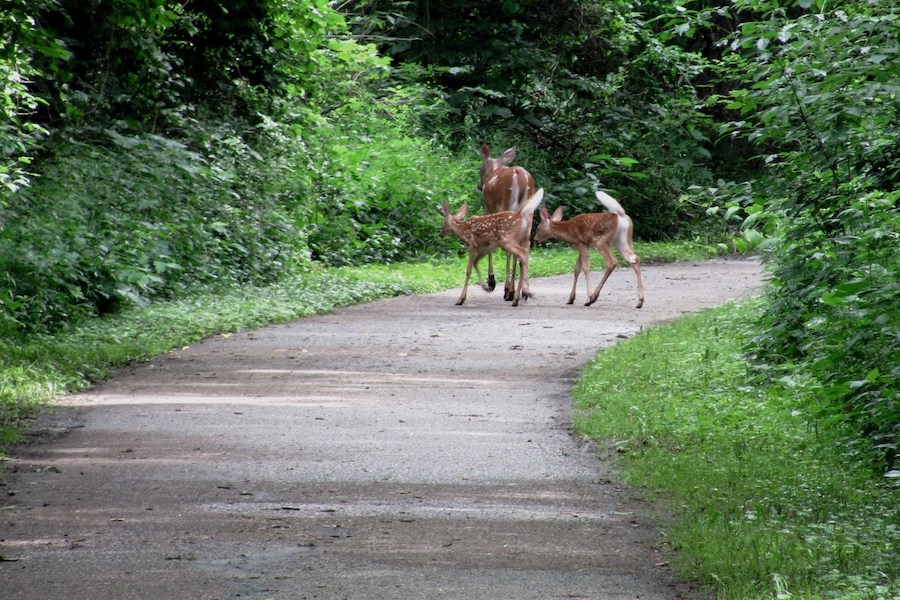
“Healthwise, we all need to get outside and spend more time in nature—not only for exercise but also just for our mental health,” White said. “I’ve been committed to that not only for myself, but to try to share with others, to share my enthusiasm. And I guess that’s turned into advocacy.”
White serves as a board member or officer with the Cedar Trails Partnership, Cedar Valley Cyclists and Cedar Valley Bicycle Collective. Through the CTP, he has helped fundraise for a group called Preserve the Cedar Valley Nature Trail, which is raising money to rebuild the Wolf Creek Bridge in La Porte City.
“I’ve been amazed at what those guys bring in,” Manning said “There are $20 donations and $20,000 donations.”
The estimate to replace the bridge is $854,000. Through grassroots fundraising, the group has raised about $100,000, and Black Hawk Conservation has obtained two trail grants that total $746,000, as well as a $50,000 pledge from a family foundation. Because one of the grants isn’t available until October, White said the fundraising effort continues to ensure that the money is there if tariffs drive the price of steel higher.
Currently, the county recommends a 9-mile detour around the bridge, and trail traffic has decreased substantially in La Porte City since the bridge was blocked off. Local businesses are feeling the absence of riders, according to the La Porte City mayor. “If there is any one thing I’ve been asked most in my four years as mayor, it’s, ‘When will we get the bridge done?’” Dave Neil said.
Mayor Neil is one of many who’ve pitched in on the fundraising effort. In April, he joined a collection of the town’s residents at a pork tenderloin dinner and auction at the La Porte City Golf Club that raised $7,500 in three hours, just one of many fundraising efforts to support a trail that was set on fire soon after its creation.
From Reviled to Renowned
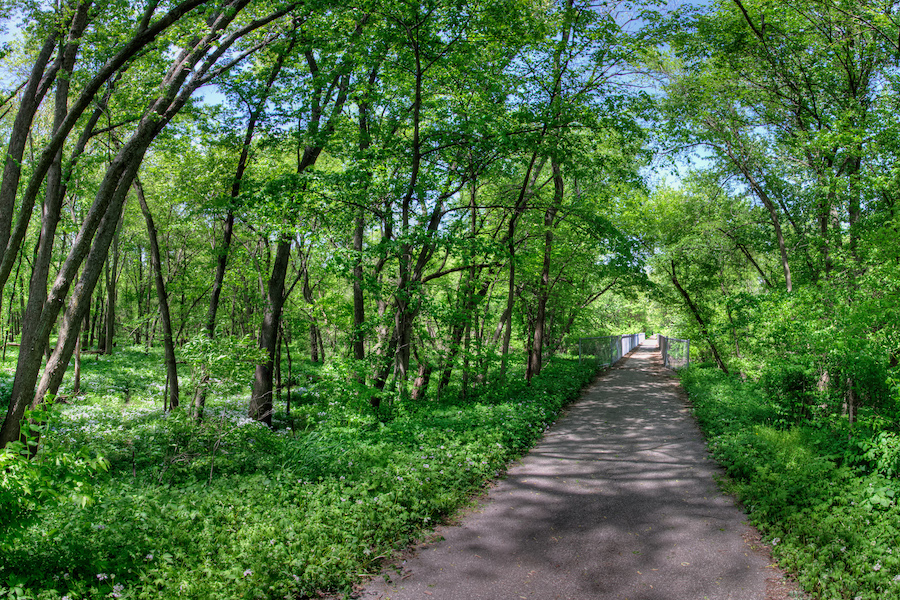
When development of the Cedar Valley Nature Trail was in its early stages, so too was the rails-to-trails movement. Railbanking was established in 1983. Rails-to-Trails Conservancy wouldn’t be founded until 1986. In between, the trail officially debuted in 1984.
The trail runs along the path of the former Waterloo, Cedar Falls and Northern Railway, aka the Cedar Valley Road, a once-thriving electric interurban line that ran eight cars daily during its heyday and also featured freight traffic over nearly 100 miles of track. It was purchased by two major railroads in 1956 and eventually abandoned in 1977.
A group led by a Waterloo TV-station owner formed Old Interurban Trail, Inc. and bought the land in 1981 for $650,000 to develop the corridor into a hiking trail. A recently formed conservation group, Iowa Natural Heritage Foundation (INHF), joined the cause. But some landowners along the trail weren’t thrilled about it.
“There was tremendous support and very vocal opposition, from what I know, in the early days,” said Lisa Hein, INHF senior director for conservation programs.
Concerns of vandals and thieves arose during public meetings. The La Porte City Council passed a resolution in opposition to the trail. Boards with exposed nails were buried just beneath its surface. And then an arsonist set fire to the Spring Creek bridge.
“That really riled a lot of people who’d been neutral before,” Rick Young of Old Interuban Trail, Inc. told a Kansas City Times reporter in 1988.
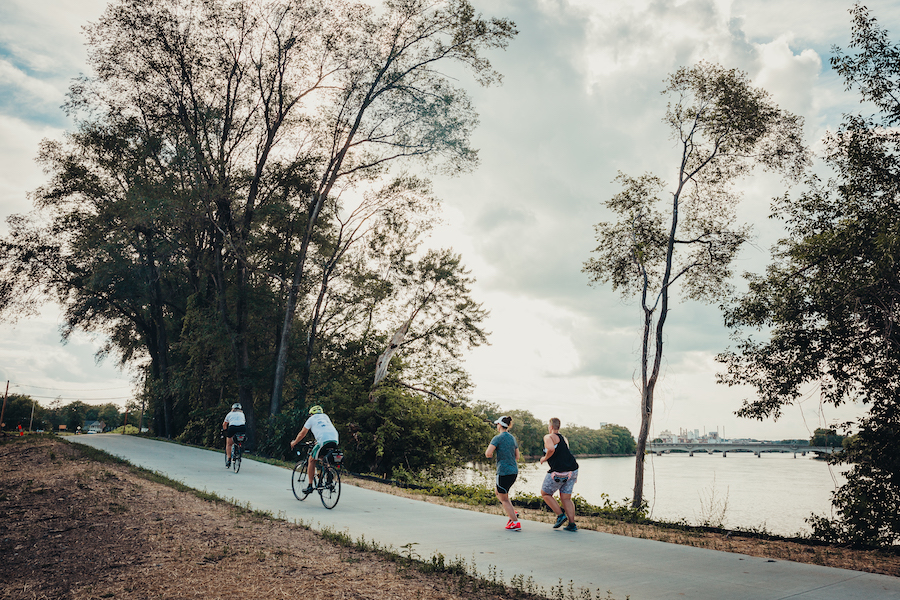
In anticipation of a vigorous public debate about the merits of developing the now-renowned Katy Trail in Missouri, the KC newspaper sent a reporter to eastern Iowa to see why opposition had mostly calmed.
RELATED: Missouri’s Katy Trail State Park: A Hall of Fame Trail
“I was very skeptical of the trail,” La Porte City’s then-police chief, Larry Feaker, told the Times. “But it proved us wrong. The people out there aren’t vandals or thieves. They’re out for the scenery, a good time.”
In some cases, it didn’t take years for landowner opinions to change. Evansdale City Council Member Dick Dewater has been researching the history of the trail in advance of a May 18 event at the Gilbertville Depot, which he pushed to restore. At the Grout Museum in Waterloo, Dewater has been poring over the archives related to the trail, and he found a note from Mark Ackleson, who oversaw the trail’s development through the INHF and has his own trail now. It was a piece of paper chronicling the negotiations over a key sliver of land with a farming family that owned it. They wanted $36,000. Dewater said the note gets into the back-and-forth a little before finally revealing the sale price.
“They made the deal for $5,000 and two 10-speed bicycles,” Dewater said. “That’s the funny thing now. A lot of those landowners who resisted use the trail. It’s part of their life now.”
Related Links
– Cedar Valley Nature Trail
– Linn County Trails Association
– Cedar Falls Tourism and Visitors Bureau
– Cedar Trails Partnership
– Cedar Rapids Tourism
– Bike Iowa
Trail Facts
Name: Cedar Valley Nature Trail
Used railroad corridor: Waterloo, Cedar Falls and Northern Railway
Trail website: CedarValleyNatureTrail.com
Length: The original Cedar Valley Nature Trail is 52 miles long; extension projects in Linn County have increased its length to 67 miles.
Counties: Benton, Black Hawk, Buchanan, Linn
Start point/end point: The northern trailhead in Evansdale is located off River Road, south of I-380. The southern trailhead in Ely is located at Dows Street and Main Street, just north of Ely City Hall.
Surface type: Asphalt and crushed limestone
Grade: With a grade of less than 2%, the trail is as smooth as the soft-serve available at the four ice cream shops that dot the path.
Uses: Walking, bicycling and inline skating; wheelchair accessible. In addition to hiking and biking the trail, you can utilize the trail for cross-country skiing in the winter, as well as snowshoeing and snowmobiling (on designated unpaved surfaces), as there is no snow removal service.
Difficulty: The trail’s surface is asphalt from Evansdale down to McFarlane Park, where it transitions to crushed limestone for about 20 miles into Center Point before converting to asphalt again. Eventually, the plan is to pave the entire path. A detour around Wolf Creek bridge, which is not in service in 2019, adds about 9 miles to the route and includes some moderate hills.
Getting there: Downtown Cedar Rapids is just minutes from the Eastern Iowa Airport (2121 Arthur Collins Pkwy. SW, Cedar Rapids).
Access and parking: The trail runs close to I-380 from start to finish, and can be reached quickly via several I-380 exits: the northern trailhead in Evansdale is off Exit 70, the Boyson Road trailhead in Hiawatha is about a half-mile off Exit 25, and the southern trailhead in Ely is reachable via Exit 13.
To navigate the area with an interactive GIS map, and to see more photos, user reviews and ratings, plus loads of other trip-planning information, visit TrailLink.com, RTC’s free trail-finder website.
Rentals: Cedar Rapids bike shops Hall Bicycle (419 Second Ave. SE; 319.362.1052) and Goldfinch Cyclery (120 Second St. SE; 319.775.0203) offer rental options. North of the trail in Cedar Falls, Bike Tech (217 Washington St.; 319.266.5979) also offers hybrid and mountain bikes.

Donate
Everyone deserves access to safe ways to walk, bike, and be active outdoors.

